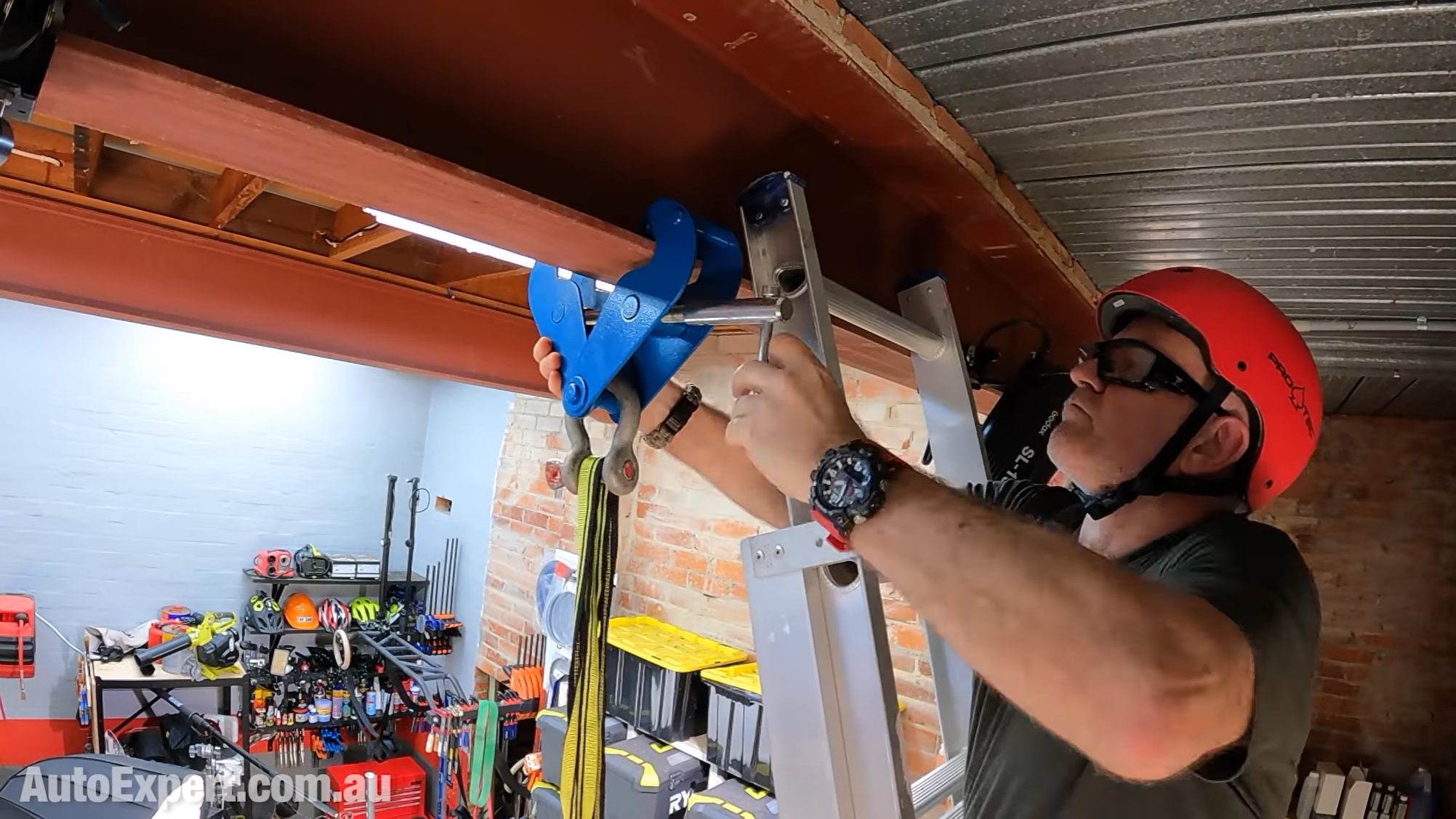How to use a ladder safely
You versus gravity. How to use a ladder without visiting your local hospital's overworked emergency department. A public service announcement…
This is not an especially automotive report but it is very important if you’re going up on a ladder around your home or workplace any time soon.
Falls from ladders kill more people annually than car crashes - but there are no million-dollar government ad campaigns targeting gravity as one of the biggest killers in the average Australian backyard. Here’s how you can stay safe, up there.
This standalone report came from my recent BMW 420i review >>. This public service announcement revolves around me upgrading the Fat Cave by jamming one of these load-bearing beam clamps onto the steel beam overhead, which holds up Level One of my house.
And the reason for doing that was to dangle my punching bag better in front of me, so that it can more effectively mock me and destroy my will to live. Punching bags are really good for that. Better than a dozen psychiatrists, and cheaper.
It requires some ghetto engineering and you should become intimate with flanges on an I beam in this way, instead of welding a fixture on, or drilling a hole in it, which could easily end in tears, unless you really know what you are doing.
These clamps are affordable, and purpose built. Ideal for punching bags, light chain blocks, or whatever related overhead equipment your bespoke dungeon requires.
Obviously, to do this, I had to get 4.2 metres up a ladder, which is quite high. This is a potentially dangerous thing to do.
So, without being a complete jobsite safety OCD freak, I wanted to some tips for you on doing this, and getting back to earth in one piece.
Obviously, my aim here was not to be definitive on ladder safety, but (perhaps) to add some ammunition to your personal ‘don’t fall off a ladder’ arsenal.
And I got some fascinating responses from you. Like this, from Tony Henderson:
In principle I agree with this, but the counterpoint to be made is: The best way not to crash in a car is never get in one. The best way not to get injured using an angle grinder is: Don’t ever use one. And the best way not to get run over is: Never cross the street.
So, that’s not always practical, and I hate the thought of living what remains of my life wrapped in cotton wool.
I think you have to be realistic about your physical and mental condition and your ability.
If you do commit to any activity, especially risky ones, you have to stack the deck in your favour.
The reason I’m including this comment - apart from liking the idea of having as many constructive voices on the channel as possible, and not being especially afraid to admit my flaws, is this:
I know what it’s like to let yourself go, and be a proper slob. When I got serious about YouTube, I’d just spent three years, or something, hosting midnight to dawn radio, battling my body clock. It’s like flying to Europe once a week: all the jet lag, but no Florence.
It physically killed me - eating badly and no longer working out, putting on 13 kilos, and generally becoming a disgusting slob.
If you’re deeply unfit, struggling to do basic bodily functions, don’t climb ladders.
About three years ago, I decided to turn this around, although without any aspirations other than to function again.
So, I can tell you that being a lazy, fat slob, makes a huge difference to functionality generally - physically and mentally. As an experiment, ‘Does if/how you train affect how you function?’ Yeah, it does a lot.
You have to be honest and impartial about your general physical ability, state of fitness, health, sense of balance when it comes to climbing up ladders and mobility - if you’ve become a slob, perhaps you should remain on the ground and concentrate on un-ruining yourself physically, which is not fun, but it’s definitely worth it.
Now this somewhat sobering message from David Brayshaw:
Thank you so much for that, David.
On behalf of everyone who reads this, I’m sincerely sorry to hear about your son’s friend. This kind of thing is very confronting indeed.
But perhaps the gravity of that, combined with you taking the time to make those excellent points, with which I agree wholeheartedly, incidentally, might inspire some people to use ladders more safely henceforth. Let’s hope.
If you’re not trained in ladder safety by the nature of your work, keep reading…
Obviously there’s no tracking system for falls that don’t occur, because of intervention like this, so we’ll never know, but I suspect this kind of input is extremely helpful. And, of course, I’m glad you survived your dispute with Isaac Newton’s apple theory.
One other point: Aluminium ladders are an excellent conductor of electricity. So look up, for overhead wires, when working around home, and realise that lighting circuits are not typically protected by core-balance relays (AKA safety switches, or residual current devices).
Fibreglass is a better material to prevent you becoming an effective conduction path to earth, but it is typically more expensive.
My AutoExpert AFFORDABLE ROADSIDE ASSISTANCE PACKAGE
If you’re sick of paying through the neck for roadside assistance I’ve teamed up with 24/7 to offer AutoExpert readers nationwide roadside assistance from just $69 annually, plus there’s NO JOINING FEE
Full details here >>
AutoExpert DISCOUNT OLIGHT TORCHES
These flashlights are awesome. I carry the Olight Warrior Mini 2 every day - it’s tiny, robust, and super useful in the field or in the workshop. Olight is a terrific supporter of AutoExpert.
Use the code AEJC to get a 12% discount >>
LADDER LOGIC
Now this, from commentary from a former ladder industry insider:
A brilliant perspective, Daniel.
A former special forces soldier once told me among the most terrifying things he ever did was civilian parachuting.
This guy had done HALO jumps at night over some very hostile places, but he’s terrified jumping in the middle of the day with a bunch of amateurs, mainly because of how casual they were in respect of the safety processes.
This happens in Bunnings every day - all those slicing, dicing and potentially deadly machines on sale. You can buy a chainsaw and a five-inch angle-grinder, and a ladder, and unless you work in industry or Defence, nobody’s going to stop you failing to use every safety procedure in the book. Using a drop saw at home remains the wild, wild west of personal risk.
It sounds trivial, but using a ladder at home is quite dangerous.
Breaching basic safety processes with tools and equipment is breathtakingly easy to do for backyard consumers.
Using an angle grinder one-handed while wearing heavy gloves, taking the guard off, and standing in line with the blade. Ticking every box.
I saw a local guy using a chainsaw the other day. He’s taken the time to put on ear muffs - but no eye protection. It’s mind boggling; I had to look away.
The point here is personal responsibility.
You probably don’t think about putting on a seatbelt when you get in a car, and it’s probably a long time in between crashes. So, a hypothetical argument could be that wearing a seatbelt is useless, or redundant, even unnecessary. (For complete disambiguation: Always wear a seatbelt.)
These processes are meant to deliver a multi-layered protection system.
Humans are not designed, physiologically, to fall from the trees anymore. So…
Make sure:
The ladder’s on a safe, stable, level foundation;
It’s at the right angle;
Put your phone in your pocket;
Put your brain in a box(helmet);
Safety glasses on;
Keep your belt buckle between the rails';
Tell someone you’re going up there;
Be sufficiently fit and capable enough to the extent that this activity is not a physical challenge;
If it feels dodgy, stop, and re-calibrate.
I hope this helps. The last thing emergency services needs - especially right now, in the midst of the Omicron COVID outbreak - is you to attend to, lying on the floor, with a cracked skull.
































There’s a new Navara ute coming to Australia after 10 years of dwindling sales and an il-fated cross-breeding with Mercedes. Is the new Navara finally worth your time and money, or is it simply a re-badged Triton?